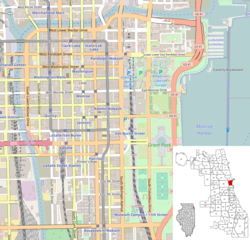The Chicago Loop Synagogue is an Orthodox Jewish synagogue, located at 16 South Clark Street, in the Loop precinct of Chicago, Illinois, in the United States. Completed in 1958,[3] the synagogue is renowned for a stained glass artwork by Abraham Rattner.[1]: 72
| Chicago Loop Synagogue | |
|---|---|
 | |
| Religion | |
| Affiliation | Orthodox Judaism |
| Ecclesiastical or organisational status | Synagogue |
| Status | Active |
| Notable artworks |
|
| Location | |
| Location | 16 South Clark Street, Loop, Chicago, Illinois 60603 |
| Country | United States |
| Geographic coordinates | 41°52′54″N 87°37′53″W / 41.88167°N 87.63139°W |
| Architecture | |
| Architect(s) | Loebl, Schlossman & Bennett |
| Type | Synagogue |
| Style | Modernist |
| Date established | 1929 (as a congregation) |
| Completed | 1958 |
| Specifications | |
| Site area | 5,000 square feet (460 m2) |
| Materials | Glass, metal (brass and bronze} and concrete |
| Website | |
| chiloopsyn | |
| [1]: 104 [2] | |
The synagogue was founded in 1929 by the United Synagogue of America to serve the needs of Jewish professionals working in Chicago’s downtown business district, providing kosher food and a place to pray during the workday. Following the COVID-19 global pandemic, there were concerns that, due to the exodus of workers from the city center, the synagogue would be unable to sustain its future operating costs.[4][5][6][7]
Architecture and design
The building was designed by architects Loebl, Schlossman & Bennett, who also designed the Richard J. Daley Center.[8][9] Completed in 1958, the synagogue building replaced a synagogue on the same block that had been lost to fire.[2]
A sculpture Hands of Peace by Nehemia Azaz is situated over the entrance doors.[1]: 105 The work depicts "priestly hands raised in benediction" (the Priestly Blessing).[10]
Let There Be Light
Abraham Rattner's 30 ft × 40 ft (9.1 m × 12.2 m) Let There Be Light [a] occupies the entire eastern wall of the second-floor sanctuary. It stands in juxtaposition to the "reserved minimalism" of the rest of the interior.[2] The art depicts images from Genesis 1:3 and Jewish religious symbols including a menorah, a shofar and an etrog. Additional influences include kabbalistic symbolism of "the force and the spirit of the ineffable and unknowable power".[11]: 114–115
It was described as "[p]erhaps the most beautiful synagogue interior in the United States".[12] Another critic said the glass "bathes the sanctuary in a shower of color, artistically consecrating the space as a place apart from the grey concrete scene on the other side of the glass".[13]
See also
Notes
References
Further reading
- Wolfe, Gerard R. (2004). Chicago in and Around the Loop: Walking Tours of Architecture and History (Second ed.). McGraw-Hill. pp. 414–415. ISBN 0071422366. OCLC 951323502.
- Frystak, Alyssa (207). "Chicago Loop Synagogue" (PDF). Historical American Building Survey: HABS No. IL-343 – via ShulCloud.
External links
- Official website
- Buildings: Chicago Loop Synagogue PBS (video clip)



